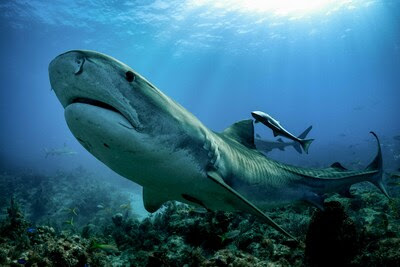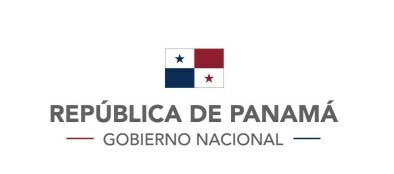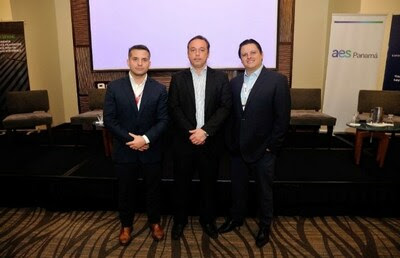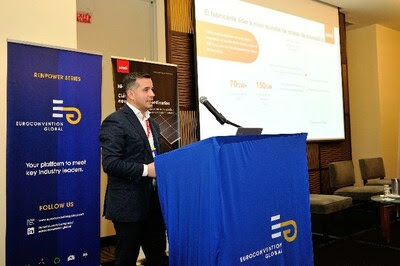Panama Achieves 50% Ocean Protection with Newly Expanded Banco Volcán Marine Protected Area
PANAMA CITY, March 2, 2023 /PRNewswire-HISPANIC PR WIRE/ — On March 2, 2023, during the opening ceremony of the 2023 Our Ocean Conference, Laurentino Cortizo, President of Panama, and Milciades Concepción, Minister of Environment, signed the decree to substantially expand the limits of the Banco Volcán Area of Managed Resources (Banco Volcán AMR) to further protect and steward important marine ecosystems, endangered flora and fauna, and important fishing resources found within Panama’s territorial waters in the Caribbean Sea. The expansion increases the size of the Banco Volcán AMR from approximately 14,200 sq km to over 90,000 sq km, with at least half of the total zone designated as a fully protected marine area where no extractive or environmentally damaging activities will be allowed.

“Today I am proud to announce that Panama is not going to stop at just having 30% of its exclusive economic zone under some level of protection, but here, at this moment and in front of more than 400 people from all over the world, together with the President of the Republic of Panama, His Excellency Mr. Laurentino Cortizo Cohen, we have signed the executive decree that expands the Banco Volcán Area of Managed Resources; therefore, as of today, through this conference, we announce that the Republic of Panama will be conserving 54.26% of its exclusive economic zone.” - Milciades Concepción, Panama’s Minister of Environment.
With this act Panama achieves the protection of more than 50% of its total marine area, becoming one of the few nations globally to reach such a milestone—and the only one in Latin America—and significantly surpasses the goal of protecting at least 30% of the country’s marine area by 2030 (30×30), an international target recently adopted by roughly 190 countries during the 15th United Nations Biodiversity Conference and that scientists say is critical to help stop the global loss of biodiversity.
The decision follows a commitment made by the government of Panama during the United Nations Ocean Conference held in Lisbon, Portugal in 2022, where Panama’s Minister of the Environment expressed Panama’s intention to expand its protected marine area from 30% to at least 40% before 2024. Subsequently, in July 2022, the Minister of the Environment requested the support of the Smithsonian Institute of Tropical Research (STRI) to conduct scientific research necessary to expand the boundaries of the Banco Volcán protected area and prepare its management plan and zoning, and thus contribute to the regional effort to protect “this great marine ecosystem.” Other organizations, including the Blue Nature Alliance, MigraMar, Mission Blue, The Wyss Foundation and SeaLegacy also offered their expertise across a range of areas, providing scientific, technical, policy and communications support to help achieve this ambitious marine protection effort, the first of its kind in Latin America.
“Panama’s leadership in expanding Banco Volcán has demonstrated that commitment and action on marine conservation can go beyond the standard target of protecting at least 30% of the ocean. We hope the world, and particularly other Caribbean countries, will follow Panama’s lead and protect at least 30% of their national waters—or increase their ambition beyond that commitment,” said Joaquín Labougle, Blue Nature Alliance regional lead for the Caribbean and Latin America. “The Blue Nature Alliance, with other partners, is pleased to support Panama’s leadership in protecting the marine environment for the benefit of people and nature and remains ready to collaborate with other countries on large-scale ocean conservation.”
The Banco Volcán AMR was first established by executive decree in 2015 following the conclusion of a technical study that revealed the area as having unique natural characteristics. However, its original extension did not support connectivity with other existing or anticipated protected areas of the surrounding countries in the Caribbean Sea region. A new technical study conducted by the Ministry of Environment in collaboration with Smithsonian Tropical Research Institute determined that expanding the Banco Volcán AMR is necessary to help build resilience within marine ecosystems against the effects of human pressure and the climate crisis, to protect marine fauna and the deep-water environments of Panama and the Southwestern Caribbean, and to support the connectivity of migratory routes that are critical to the survival of pelagic and marine-coastal species.
“We strived to obtain the best scientific evidence to achieve this expansion and thus guarantee the smooth implementation of the marine protected area, which will provide benefits for the coastal communities of the region and will support biological connectivity with other oceanic and continental marine protected areas with the rest of the coastal-marine zone of the Caribbean Sea. Collaborating with the government of the Republic of Panama, we have once again achieved an example of scientific diplomacy.” - Hector Guzmán, Senior Staff Scientist at the Smithsonian Tropical Research Institute and a member of the MigraMar network.
The expansion of the Banco Volcán AMR encompasses four submarine ridges, recognized as aggregation sites for pelagic species, as well as deep plains and geological formations linked to high biodiversity that includes highly migratory and endangered pelagic species. The expanded Banco Volcán AMR is important for the protection of 120 species of pelagic fish, including three species considered to be critically endangered: the scalloped hammerhead shark (Sphyrna lewini), the great hammerhead shark (Sphyrna mokarran) and the oceanic whitetip shark (Carcharhinus longimanus); and five species considered to be endangered, including the whale shark (Rhincodon typus), the mako shark (Isurus oxyrinchus), two sharks associated with great depths (Centrophorus granulosus and Centrophorus tessellatus) and the giant oceanic manta ray (Mobula birostris). Nevertheless, the authors of the technical study to support the expansion of the Banco Volcán AMR emphasize the need for increased scientific research in the region, stating that until more studies can be completed, the total number of species must be regarded as a considerable underestimate.
“Congratulations to the beautiful nation of Panamá, President Laurentino Cortizo and Minister Concepción, for expanding yet another marine protected area, this time in the Caribbean Sea, and helping accelerate regional collaboration to safeguard critical marine ecosystems. With the expansion of Banco Volcán, Panamá will now protect over 50% of its waters, and is leading the world in ocean diplomacy, science, and conservation. We are deeply inspired by Panama’s commitment to protect and restore our ocean and hope to see world leaders following their ambitious example,” - Cristina Mittermeier, co-founder, SeaLegacy.
The expansion will also support connectivity with other marine protected areas in the Caribbean Sea, helping advance regional collaboration with Colombia, Nicaragua, Honduras, Jamaica, and Costa Rica to help stop the loss of marine biodiversity. It will also help promote increased scientific research to generate enhanced knowledge about marine biodiversity, migration patterns, conservation status, and the effects of human activities including climate change. Ultimately, the expansion will help build a network of marine protected areas across the Caribbean Sea in close partnership with neighboring nations.
“Once again, the American continent continues to show its leadership in protecting the ocean, however, Panama has set the bar quite high, with an indisputable legacy and the necessary response to the planetary crisis we’re experiencing today. - Max Bello, Ocean Policy Advisor, Mission Blue.
By taking this action, Panama once again demonstrates its commitment to the protection of marine biodiversity and the responsible management of marine resources, serving as a visionary Blue Leader committed to highly and fully protecting the ocean and to making decisions based on the latest scientific research. Panama hopes that its leadership in the protection of the marine environment will accelerate regional and global collaboration to catalyze the conservation of the ocean and to advance the implementation of large-scale ocean conservation efforts.
About Blue Nature Alliance
The Blue Nature Alliance is a global partnership that collaborates with governments, NGOs, local and Indigenous communities, scientists, and other organizations to catalyze and accelerate large-scale ocean conservation. The Alliance supports the marine conservation work of more than 60 partners in approximately 25 sites across the globe, in all five oceans and the high seas. It was founded and is led by Conservation International, The Pew Charitable Trusts, The Global Environment Facility, Minderoo Foundation, and the Rob & Melani Walton Foundation. Learn more at https://bluenaturealliance.org.
About SeaLegacy
Founded in 2014 by the world’s leading conservation photographers and explorers, Cristina Mittermeier, Paul Nicklen, and Andy Mann, SeaLegacy is the global marketing, education, and communication agency for the ocean. At the nexus of climate action and sustainable solutions, we create strategies and content that instill hope and move audiences into action. SeaLegacy’s mission is to use strategic communications at the intersection of art, science, and conservation to protect and rewild the ocean within our lifetimes. Guided by science and driven by purpose, SeaLegacy brings ocean stories and solutions to light for the benefit of biodiversity, humanity, and climate. www.sealegacy.org
About Smithsonian Tropical Research Institute
The Smithsonian Tropical Research Institute was founded with the purpose of increasing and sharing knowledge about the past, present and future of tropical ecosystems and their relevance to human welfare. This work began in Panama in 1910, when the Smithsonian led one of the world’s first major environmental impact studies, which surveyed and cataloged the flora and fauna of the lowland tropical forests that would be flooded with the creation of the Panama Canal. A century later, the Smithsonian in Panama is a standard-setting global platform for groundbreaking research on tropical forests and marine ecosystems and their astounding biodiversity. Today, STRI employs 40 staff scientists and hosts some 1,400 scientific visitors every year, from undergrads and interns to postdoctoral investigators and tenured research associates. Together, they collaborate on 350 running research projects and publish more than 400 peer reviewed articles in scientific journals every year. The research is not only shared widely around the global scientific community, but also reaches policymakers in Panama and beyond, receives media coverage around the globe, and is the foundation of an outreach and training program that reaches hundreds of teachers and tens of thousands of schoolchildren every year.
About Mission Blue
Mission Blue inspires action to explore and protect the ocean. Led by legendary oceanographer Dr. Sylvia Earle, Mission Blue is uniting a global coalition to inspire an upwelling of public awareness, access and support for a worldwide network of marine protected areas – Hope Spots. Under Dr. Earle’s leadership, the Mission Blue team implements communications campaigns that elevate Hope Spots to the world stage through documentaries, social media, traditional media and innovative tools like Esri ArcGIS. Mission Blue also embarks on regular oceanic expeditions that shed light on these vital ecosystems and build support for their protection.
About the Wyss Foundation
The Wyss Foundation is a private, charitable foundation dedicated to supporting innovative, lasting solutions that improve lives, empower communities, and strengthen connections to the land. To confront the global conservation crisis, the Wyss Foundation launched a $1.5 billion campaign called the Wyss Campaign for Nature. The campaign’s goal is to help conserve 30% of the planet in a natural state by the year 2030 by creating and expanding protected areas, implementing international conservation targets, and inspiring conservation action around the world.
About MigraMar
MigraMar is the leading scientific authority in migratory species research in the Eastern Pacific Ocean (EPO). Over the last fifteen years, MigraMar have identified critical areas where migratory species are more vulnerable, including feeding and breeding grounds, and areas where seasonal migrations occur. These results have informed governments and stakeholders on the functioning and connectivity of marine protected areas (MPAs), and have supported decisions to improve protection for migratory species across the region. MigraMar has delivered scientific evidence to support the creation of new marine reserves and expansion of existing reserves. The total area of MPAs has increased fourfold, from 156,000 km2 in 2010 to 630,000 km2 in 2022, providing larger grounds for migratory species to move without risk of capture. Our Swimways Initiative has been adopted by national authorities and is currently used as the binding tissue for regional governmental collaborations.


Photo - https://mma.prnewswire.com/media/2013729/Tiger_shark_credit_Paul_Nicklen.jpg
Logo - https://mma.prnewswire.com/media/2013772/panama_Logo.jpg
Logo - https://mma.prnewswire.com/media/2013775/logos_pew_Logo.jpg






